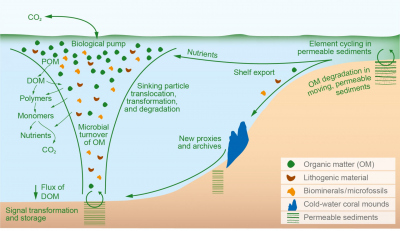- Cluster Ocean Floor
- Research Unit RECEIVER
- Research Themes
RECEIVER – Themes and Objectives
Within receiver, we will advance our understanding of the transfer of matter to the ocean floor, and how it is affected by climate change and subsequently recorded in the sedimentary record. Without this, we cannot gain a full picture of the seafloor processes and records studied in Reactor and Recorder.
Focusing on three themes, we address fundamental gaps in knowledge with respect to the mechanisms of formation and transformation, translocation, degradation, and preservation of biogenic particles within the water column and at the ocean floor - factors which collectively control the efficiency of the biological carbon pump.
Our main objectives / expected achievements are:
- To investigate the controlling mechanisms of the biological pump and its interaction with changing global biogeochemical cycles we will develop a mechanistic understanding of how matter is transferred and transformed during its journey to the ocean floor.
- To quantify the impacts of continental-shelf processes on open-ocean biogeochemistry we will reveal how the ocean floor on continental shelves acts as a buffer between land and the open ocean by filtering and transforming carbon and nutrients
- To develop quantitative models determining the origin, trajectory, and age of organic and inorganic matter that reaches the ocean floor we will examine the connectivity between surface-ocean conditions and the signatures received and integrated at the ocean floor
- To trace how ocean conditions are preserved in the ocean floor as geological archives we will establish novel and improve exisiting indicators (proxies) for reconstructing key parameters and processes in the ocean system
An organizational overview of the program is provided in the following table.
RECEIVER |
Theme 1 | Theme 2 | Theme 3 |
| Title | The transfer and transformation of sinking particles | The role of continental shelves in nutrient cycling and organic-matter transformation | The transfer of matter and signals into the ocean floor |
| Research focus, spatial | Water column | Water column, sediment-water interface | Water column, sediment-water interface, surface sediments |
| Contributions tooverarching objectives(obj.) Of the cluster | Biogenic particle transfer and transformation (Obj. 1);element fluxes and budgets (Obj. 2), and warm-world scenarios (Obj. 4) | ||
| Most important links within the cluster (T = theme) |
Transformation of biogenic particles (REACTOR T2), reconstructing carbon fluxes (RECORDER T1), upscaling from fluxes to budgets (Enabler MODELING) | Lateral biogenic particle input from the shelves (REACTOR T2);in-situ analyzes, seabed exchanges (Enabler TECHNOLOGY) | Biogeochemistry feedbacks (RECORDER T3), proxy signals to inform warm-world scenarios (RECORDER T2), signal transformation (Enabler TRACERS) |
| Key study sites | Mauritanian upwelling system, Irish margin, North Sea, Fram Strait | Mauritanian upwelling system, Irish margin, North Sea | Mauritanian upwelling system, Irish margin |
| Joint study sites | - NW African margin, NE Atlantic - | ||
| Disciplines | Biogeochemistry, organic geochemistry, microbial ecology, physical oceanography | Biogeochemistry, organic geochemistry, microbial ecology, physical oceanography, sedimentology | Biogeochemistry, organic and inorganic geochemistry, microbial ecology, micropaleontology, sedimentology |



